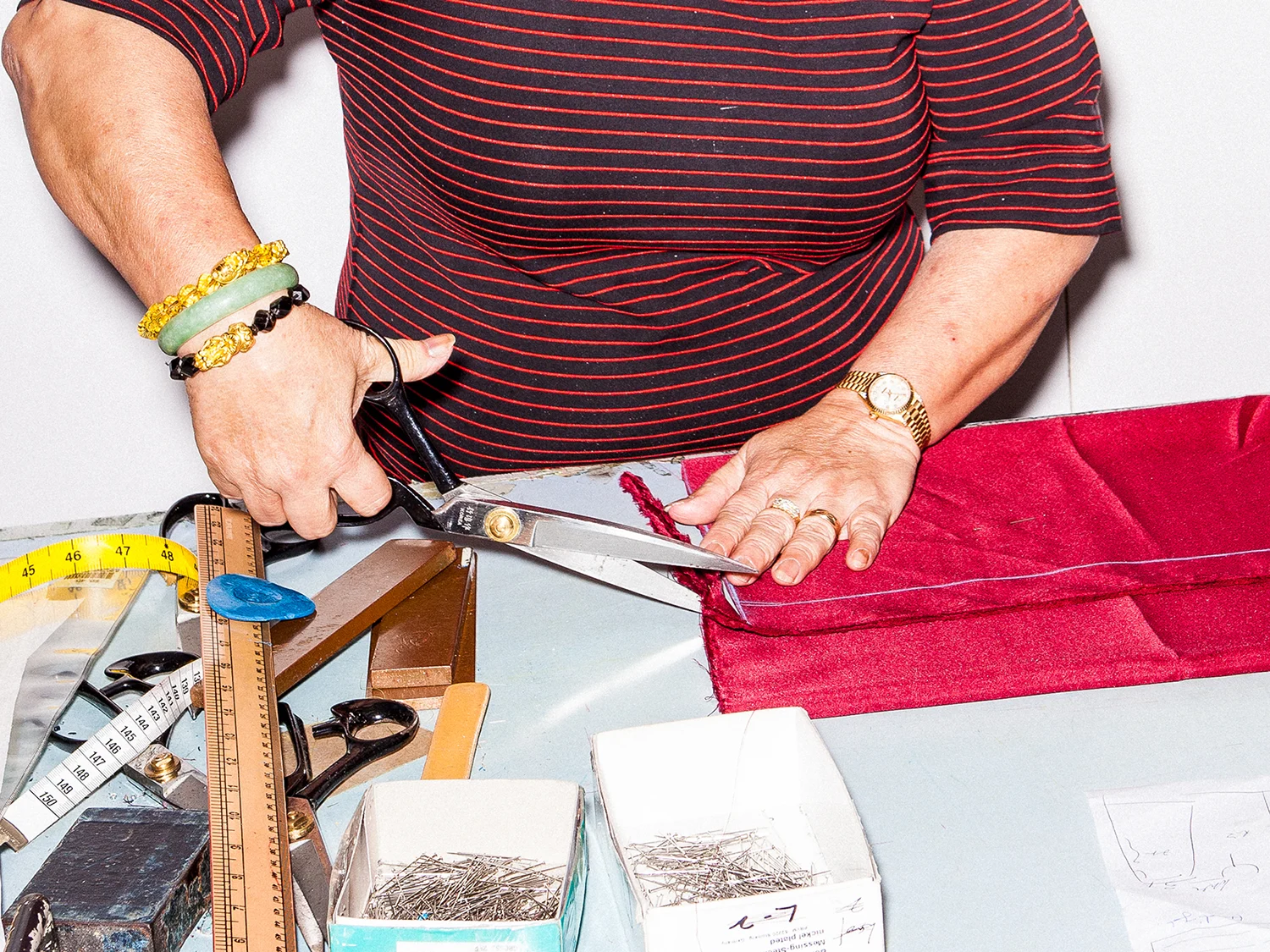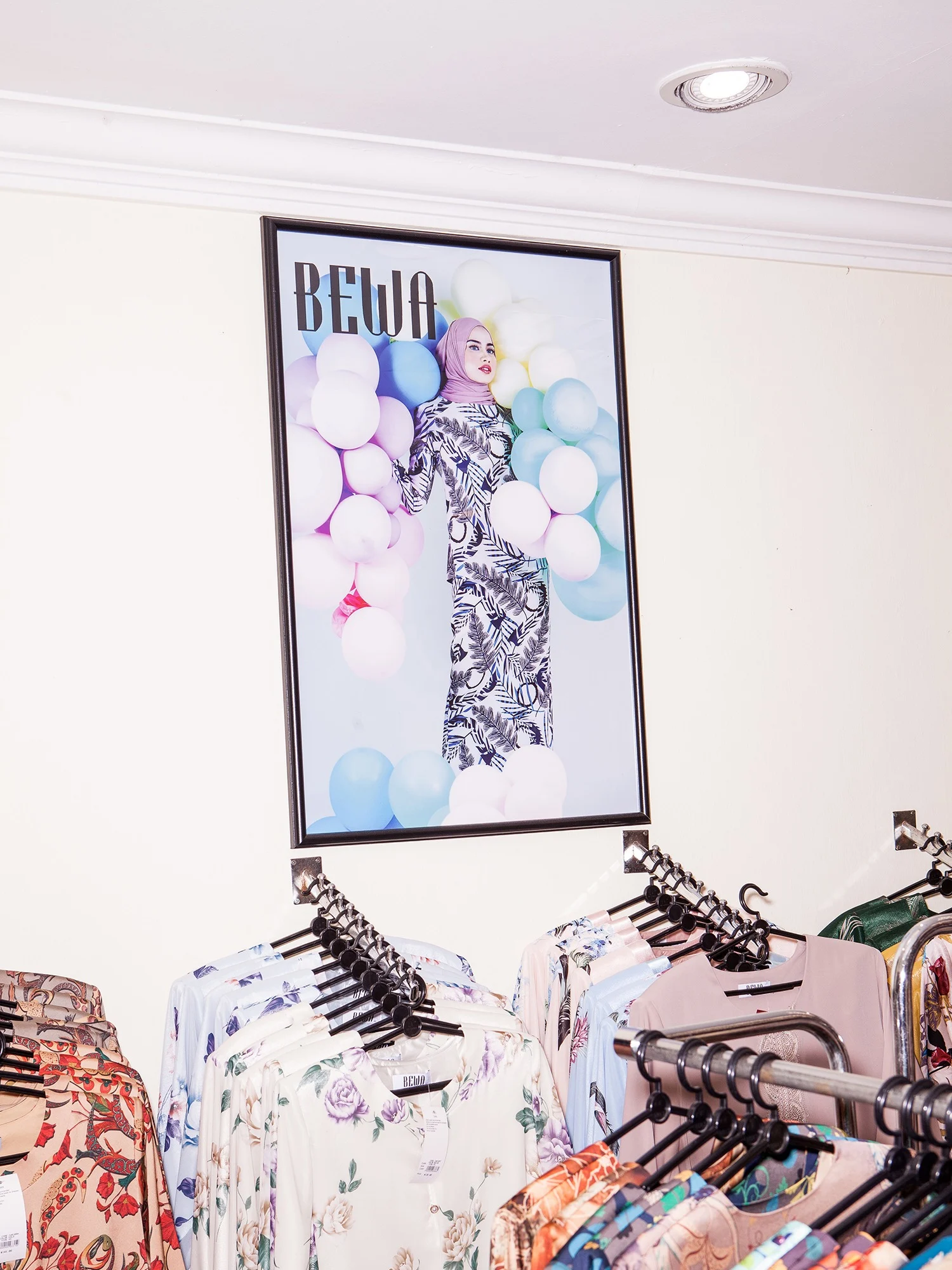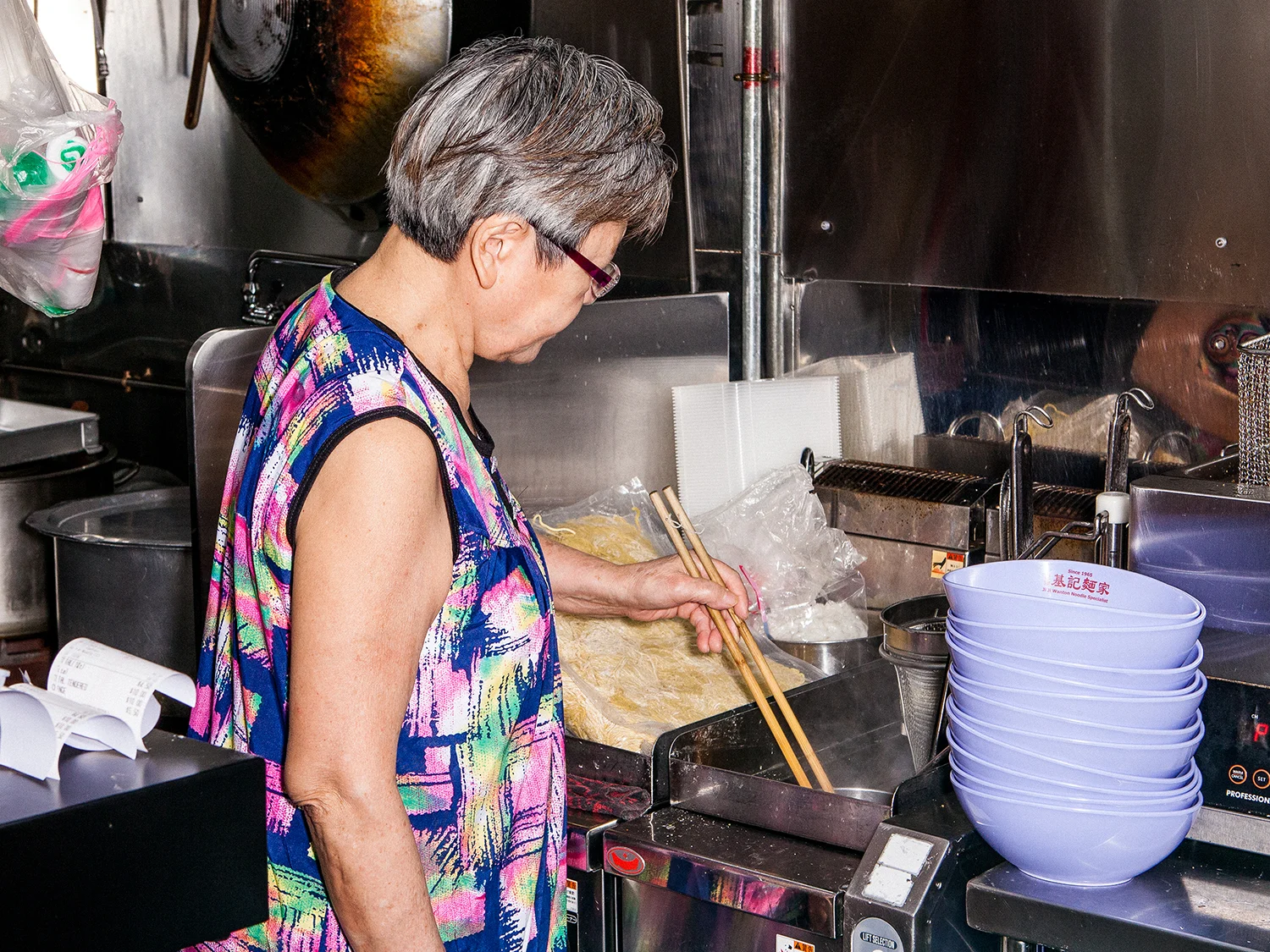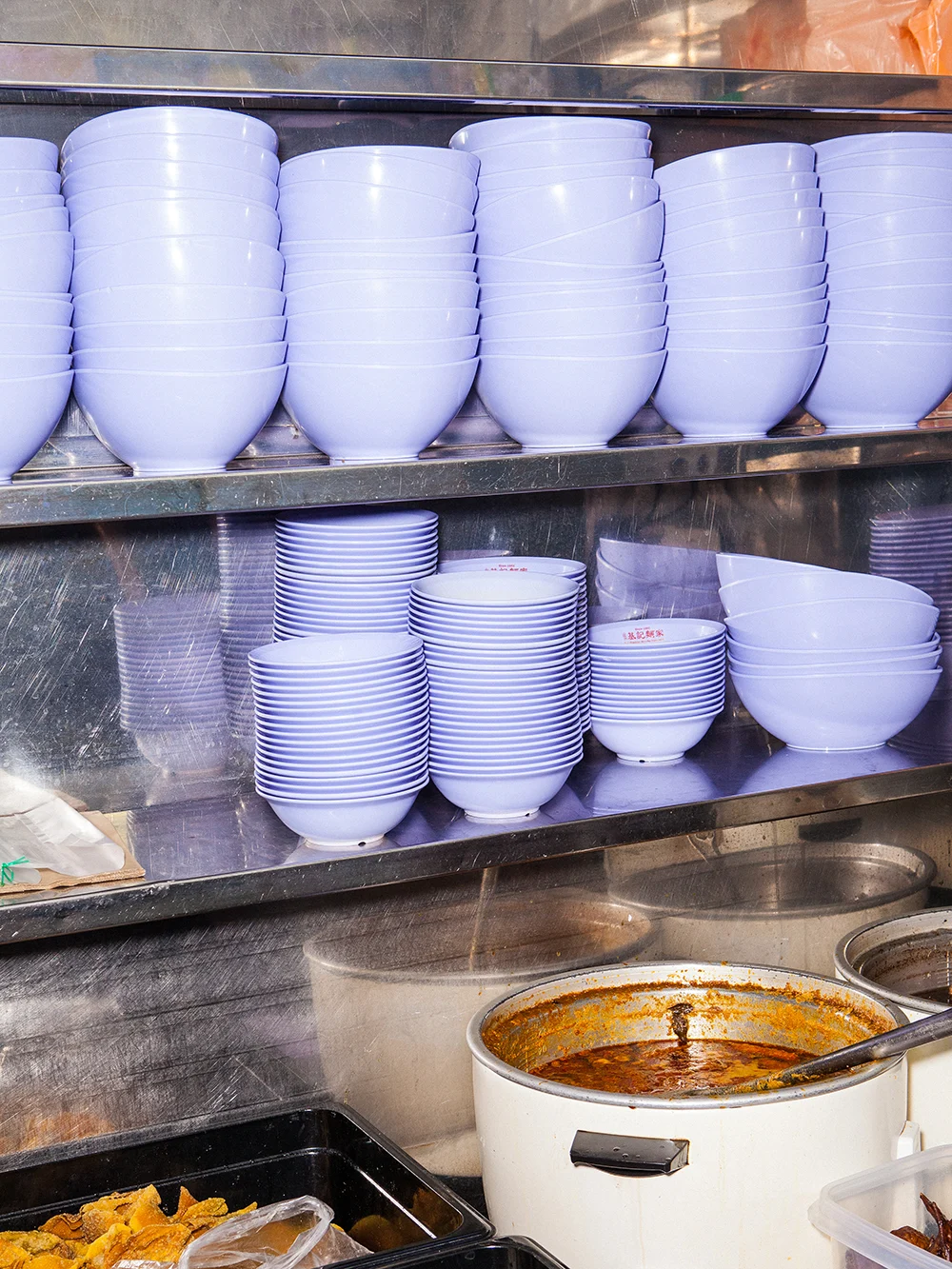

+65 is the international dialling code for Singapore. By the year 2035, it’ll also be the age of a third of the country’s population. They’re calling it the “silver tsunami.” Singapore has one of the lowest fertility rates and highest life expectancies in the world, meaning its labor force is getting significantly older too. In a nation that promotes itself as youthful and modern, its sizable proportion of elderly citizens are often absent from the national narrative.
Writer and photographer Faris Mustafa visits Singapore to meet the incredible women beyond the age of 65 who’ve overcome barriers, challenged stereotypes and are proudly and triumphantly, still working the nine to five.
Nowhere encapsulates the nation of Singapore better than its hawker centres: clean, safe, scrupulously government-regulated, a food lovers’ paradise where you’ll overhear conversations in Mandarin, Hokkien, Cantonese, English, Singlish, Tamil and Malay and see people from every ethnic and economic background - though seldom at the same table. They’re accessible, easy to navigate, the atmosphere is both welcoming and transactional, and there are elderly people, working, everywhere.
In the hawker centre they’re selling tissues for a dollar a pack, sweeping floors, clearing your plates after you finish eating, or working as bathroom attendants. Then there’s those who cook and serve your food. The average age for hawkers themselves is currently estimated at 60 years old.
It's a scenario reflective of society here as a whole. Singapore is a rapidly ageing society where, by 2035 around 32 percent will be over the age of 65. The country’s employment rate for those aged 65 and above leapt from 13.8% in 2006 to 28.7% in 2019. At present, one in four seniors are still working.
As the world’s most expensive city, for some, retirement isn’t financially viable. The nation’s pension-equivalent Central Provident Fund is only relative to collective earnings. For many who came up when Singapore was still a developing nation, those savings aren’t sufficient in today’s economy. For women, the average CPF balance for those over 60 was, in 2016, 25% less than that of men.
Each have unique perspectives, sparkling personalities and engaging stories that deserve to be heard.
There are lots of seniors, willing and able, for whom continuing to work past the age of retirement is a choice. A matter of personal fulfilment or even a sense of duty. Many are excelling in their careers, outperforming younger peers in industries as wide-ranging as politics, law, healthcare and the environment.
It was clear to me that working, elderly people, were not only ubiquitous in Singapore, they were vital. But just like the tray cleaners and tissue sellers in the hawker centre, most operated in the shadows.
In the decades since independence in 1965, Singapore was propelled from the “third world to the first” – to quote the country’s founding father Lee Kuan Yew – and underwent major economic growth and urbanisation. Such rapid change left a socio-cultural chasm between young and old here, a generation gap between those born into a secure, materially wealthy Singapore, and their elders, many of whom had helped build the country up.
Economic growth came fast. Social progress was slower. The gender pay gap was still an issue, and old-fashioned patriarchal tendencies were hard to shake. Elderly women, known honorifically as “aunties” had it especially tough.
Growing up in an era when traditional gender roles and familial responsibilities were even harder to negotiate, career opportunities were limited and upward mobility was a struggle. Working older women here tended to be less formally-educated and with fewer savings than men. They were mainly employed in lower wage, lower skilled occupations. As a result, aunties were often the subject of stereotypes, judgments, bad jokes and negative assumptions.
This photo series was conceived with the intention of shining a light on not just those working over 65, but specifically women, who’ve overcome both the age, and gender barrier, to thrive in their careers in Singapore
Getting to know these women showed me a whole new side to a country I’d been covering for years. Singapore had become synonymous with modernity: gleaming skyscrapers, vaunted prosperity and crazy rich asians. This project took me to places that felt different, in every sense. From a remote vegetable farm to a neighbourhood mall that specialised in Islamic clothing, the women I met here were intent on ageing as active citizens. Each have unique perspectives, sparkling personalities and engaging stories that deserve to be heard.
Ivy Singh Lim
“I wake up every day at five o’clock, and then I say a prayer to the universe: ‘Thank you for giving me another day,”

“I wake up every day at five o’clock, and then I say a prayer to the universe: ‘Thank you for giving me another day,’” says Ivy Singh Lim. “After that I go outside,” she continues, “I look up at the sun, and I think to myself: which bastard should I kill today?”
Ivy, aged 71, doesn’t lack pluck. Her life has been defined by a willingness to speak up for those without a voice, vigorously challenging the status quo and earning a reputation locally as one of Singapore’s most prominent disruptors.
Since opening Bollywood Veggies, a farm and eco tourist attraction in northern Singapore (she describes her occupation as a “farmpreneur”), Ivy has championed her fellow farmers in the region of Kranji – where all the country’s last remaining farms reside – and is a staunch advocate of issues surrounding food security and sustainability.


I’m determined, before I die… I will change things.
Previously the president of the country’s netball association, the decision for her and husband to buy farmland in a remote part of Singapore was originally intended as a retirement plan. Soon it became a fully functioning community project and educational centre. Today, Bollywood Veggies encompasses a farm, a cafe, a museum and a culinary school, with dozens of full-time staff members, many from underprivileged backgrounds.
I’d read about Ivy a few years ago when she made local news for wanting to start her own all-female political party to counter what she saw as the the lazy, dishonest political elite in Singapore. "I believe women are all honest and that's why very few of them can go into politics," she was quoted as telling The New Paper. In real life, she was just as free-spoken and convicted. But she was also very fun, with a wicked sense of humour.
A couple of hours into talking with her at Poison Ivy, her farm’s in-house restaurant, Ivy hails a waiter and orders herself a whiskey. “Would you like a beer?” she asks me. “Sure”, I reply without a thought. I look up at the big wooden clock above us. 12.01pm. “The doctor told me, ‘you're gonna die if you continue to drink every day from 10am,’” Ivy tells me, “so now I’m very disciplined...I start drinking at 12 o’clock.”

Never without one of her many, former rescue dogs by her side, Ivy sits beside me wearing a plain black T-shirt, leather utility belt and khaki shorts, “I’ve never been a conspicuous consumption person,” she says. “Look at my clothes. It's all from Marks & Spencer. I don't wear a bra. I hardly wear underwear even,” she adds, “even food. I’d be happy eating spam every day”.
Ivy, her husband, and their dogs live in a large house next door to the farm where she grows everything from bananas and sweet potatoes to okra and bitter gourd as sustainably as possible, without the use of chemical pesticides or fertilizers.
Recently, Ivy discovered YouTube. Her weekly show, Coffee and Whiskey with Ivy, in which Ivy breaks down topical politics, current affairs and environmental issues stories now has tens of thousands of followers. In a country where dissent is rarely heard, let alone tolerated, Ivy’s fearless and outspoken nature is extremely rare. “I love my country”, she tells me. “If I didn't, I’d just sit back and let the fucking country blow up. But I'm determined, before I die…I will change things.”
Madam Lie Hong Haw (aka Bewa)
"I’ll always have this passion for creating dresses and coming up with new designs."

Singapore is a country that defines its racial makeup in four distinct categories known by the initialism CMIO (Chinese-Indian-Malay-Other). For the most part, local businesses serve their respective communities, with little or no crossover. Chinese dressmaker Lie Hong Haw aka Bewa’s eponymous clothing business is something of an anomaly.
Located in the Joo Chiat Complex shopping mall, Madam Lie, age 65, sells Malay womenswear – hand-sewn baju kurung and kebayas – to an exclusively Malay clientele. Her office upstairs is adorned with bright red fai chun banners, paper cuttings and buddha statues, “my parents are actually both pretty traditional Chinese people,” laughs her son Huang Jianhui, catching me looking around the place as he meets me to help translate my interview with his mother.
Madam Lie, grew up in Medan, a majority-Muslim (Malay) city in Indonesia, as the daughter of Chinese immigrants. She was the seventh child of 10. “I started sewing at 14,” she tells me. “I always felt close to the local Muslim community,” she explains, “so I learned how to make the type of clothing that was around me.”


As old as I get, I’ll always have this passion. Age is just a number.

After marrying a Singaporean-Chinese man and moving here with him in the ‘80s, the couple eventually started a tailoring business together in 1993 in the Malay-centric community of Geylang Serai. Locals were quickly won over by Lie’s ability and knowledge of Islamic womenswear. The business gained a loyal following fast. Today it focuses on its ready-to-wear, which Lie designs herself, while still maintaining its tailoring wing.
Madam Lie doesn’t stop smiling. Not just when she talks, but even at work, when taking up measurements or talking with customers. Every day feels like a new opportunity for her to do the one thing she loves. Her enthusiasm is infectious.
Her son tells me that his mother works seven days a week, “I no off-day wan!” she adds in Singlish, “I very happy working,'' she beams. Continuing in Mandarin, “age is not a barrier when it comes to your passion. And as old as I get, I’ll always have this passion for creating dresses and coming up with new designs,” she explains, “age is just a number.”
Madam Som Said
"I work six days a week now. Sunday I relax”

“My mother was really against me dancing,'' says Madam Som Said, today Singapore’s most famous Malay dance choreographer. “That was my first challenge,'' she smiles.
Som Said recalls falling in love with dance from a young age. She watched Malay musical cinema as a kid, unable to follow the plot but completely entranced by the movements on screen. She knew this would be her calling.
“My parents were very conservative, my mother didn’t approve of it,” she says, “and although I knew she was unhappy, I was determined to find a way to make her understand what a beautiful activity it could be.” Som Said started to bring her mother to her rehearsals. Eventually, when she landed her first role as a choreographer, she convinced her mother to work as her costume designer. “She helped me with all the materials,” she explains, “she helped me to sew. And slowly,” she says, “I made her love what I do.”
Som Said has always been acutely aware of generational differences. Just like she did with her mother, Som Said continued to espouse the benefits of traditional dance to the wider Singaporean-Malay community, almost single-handedly helping it to grow exponentially in popularity, and creating opportunities to pursue dance for young people that weren’t available to her when she was a girl.


I’ll never retire! But slow down, sure.
She invites me to sit the moment I enter her Sri Warisan studio and office, and asks one of her staff to bring out a platter of Malay desserts for me to try, including bright-green kuih seri muka and deep-fried bananas (goreng pisang). Around the office are framed photos of Som Said and her students, trophies and awards, colourful performance costumes and shelves of academic books.
Around the time Madam Som Said turned 58, she enrolled to study a degree in dance anthropology, with a final thesis in “Malay dance in Singapore.” “It took me four years to complete the thesis. I finished when I was 62,” she recalls, “but then I thought: don’t stop now. So I decided to make it into a book, which was published two years ago.”
Now, at 69, she tells me she has no plans of retiring. “Never,” she says with a smile. “But slow down, sure. Most of the time now I'm just advising, curating and giving talks,” she tells me. “I work six days a week now. Sunday I relax,” she says. “But sometimes you can’t help but come back in for this and that.”
Madam Lai Yau Kiew
"We don't advertise anywhere. We just serve our regular customers, year in year out."

Ji Ji Wonton Noodle Specialist was one of the very first hawker stalls to open in the Hong Lim Market and Food Centre, set in the heart of Singapore’s CBD. It’s a little bit tucked away on the second storey in a slightly underlit row, but that doesn’t mean people don’t know about it. The stall recently topped a prominent online poll as Singapore’s “favourite hawker” in the wonton category, and even made last year’s Michelin Bib Gourmand guide.
“We don't advertise anywhere. We just serve our regular customers, year in year out,” says Madam Lai Yau Kiew, 69. “I see the fourth generation of our customers coming now, it’s always been those people who’ve helped to spread the word for us.”
Ji Ji began as an old-school pushcart hawker, operated by her father in the early ‘60s. Lai, an only child, would help out every day after school. When her father died of tuberculosis, Lai, then still a student was forced to step up and take over. “She was quite talented,” explains her daughter Kristen, “she did very well in her studies. But she had to forgo that. She couldn't take the exam because her father was sick, and when he died, she had to carry the whole burden,” she explains.


She’s so strong! She doesn’t want to stay at home.
When Singapore began to outlaw street hawkers and move them into organized, undercover hawker centres, Ji Ji Wonton Noodle moved into their current location. That was in 1976. “A lot has changed since then,'' Madam Lai says, “so many of the hawkers that were here when we opened have passed on now.”
Not long into our meeting, Madam Lai gets up from her seat, insisting I try the stall’s trademark dish. I watch as she proceeds to cook in front of me, operating the deep-fryer machine, stirring the broth with long wooden chopsticks. It occurs to me that she’s been cooking the exact same dish, every day, for over 50 years. Her movements are instinctual, almost automatic, but the wide-eyed pleasure she has in serving me that purple melamine bowl stacked with tender char siu pork, springy al dente noodles and deliciously packed won ton, is totally unjaded.

Nowadays, Madam Lai is supported at the stall by her daughters Kristen and Jill, who’ve taken over the managerial duties. “When we took over it was so tough,'' recalls Kristen. “I remember wondering, ‘how did my mother survive for over 40 years, and to raise us alone?” says Kristen, whose own father also died young.
Madam Lie may have a lighter workload now as she approaches the age of 70, but as her daughter attests, she still comes to work every day. “She’s so strong!” says Kristen. “She tells me that she likes to work. She doesn’t want to stay at home.”

